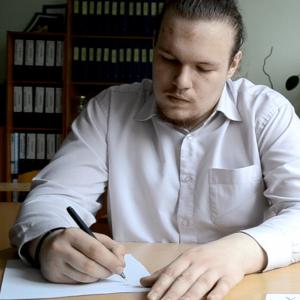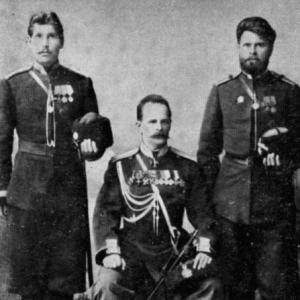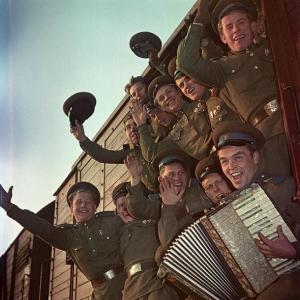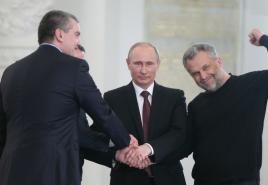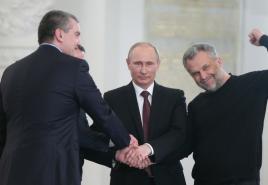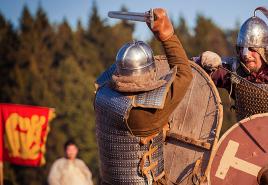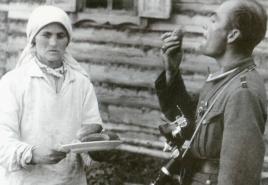Leonid artamonov. Russian general, French and Ethiopian natives
Leonid Konstantinovich Artamonov (February 25, 1859 - January 1, 1932) - Russian general and traveler, participant in the Russian-Japanese and World War I.
Biography
Born on February 25, 1859 on the Kapritsa farm of the Ananievsky district of the Kherson province. He graduated from the Vladimir Kiev military gymnasium, the Konstantinovskoe and Mikhailovskoe artillery schools (1879, graduated as second lieutenant in the 20th artillery brigade). Member of the Akhal-Tekin expedition in 1880-1881. In 1883 he graduated from the Nikolaev Engineering Academy, served in the sapper units in Nikolaev and Odessa. After graduating from the Nikolaev Academy of the General Staff in 1888, he was sent to serve in the Caucasian Military District, and in 1890 - in the Transcaspian region. Repeatedly made pozdki with reconnaissance purposes in the border regions of Turkey (1888), Persia (1889, 1891), Afghanistan (1893). In 1896 he received the rank of colonel. In 1897 he was appointed chief of the convoy of the Russian mission in Abyssinia, as a military adviser and representative of the Negus Menelik II, in 1898 he made a successful military expedition to the White Nile with the troops of Abyssinia, opposing the British colonial expansion. These events and actions of the Ethiopian troops are directly related to the Fashoda crisis, but Colonel Artamonov and his troops were late to change the balance of power, nevertheless, these actions were enough to recognize the borders of Ethiopia by all the colonial powers.
Member of the Chinese campaign against the boxers in 1899-1901. Since 1900 - Chief of Staff of the South Manchurian Detachment. Since 1901 - Major General, Commander of the 2nd Brigade of the 31st Infantry Division. Member of the Russian-Japanese War of 1904-1905.
In 1904 - Chief of the 8th East Siberian Rifle Division, 54th Infantry Division. In January 1906 - temporarily commander of the 8th East Siberian Rifle Division, and. d. commandant of the fortress of Vladivostok. From July 7, 1906 to December 14, 1908 - Chief of the 22nd Infantry Division. Lieutenant General (1907). Since December 1907, Chief Chief of Kronstadt. From March 5, 1911, he commanded the 16th Army Corps. From March 17, 1911, he commanded the 1st Army Corps. General of Infantry (1913).
An even greater crime was committed by General Artamonov on August 14, 1914, commanding the 1st Army Corps in the 2nd Army of General Samsonov. General Artamonov's corps provided the left flank of the 2nd Army at Soldau. On this day, August 14, General Artamonov personally reported to General Samsonov by telephone that his corps "stands like a rock" and that the army commander "can completely rely on him", and after 10 minutes he gave the order to withdraw the entire corps, not informing General Samsonov about this (taken from Colonel Bogdanovich's book "Invasion of East Prussia" pp. 144-145, investigation of Adjutant General Panteleev's commission about the reasons for the death of the 2nd Army).Camp gathering in 1907 (From the letters of M.V. Alekseev)
On August 18, 1914, he was removed from office after unsuccessful actions in East Prussia. Since 1914, he has been in the reserve of ranks at the headquarters of the Minsk Military District. Since 1916, in the reserve ranks at the headquarters of the Petrograd Military District. From January 29 to April 12, 1917, he commanded the 18th Siberian Rifle Division.
Member of the Imperial Russian Geographical Society since 1882.
After the October Revolution he lived in Moscow, worked in the Moscow Soviet, from 1927 to 1930 he lived in Novgorod, from 1930 - in Leningrad. He died on January 1, 1932, and was buried at the Volkovskoye cemetery in Leningrad.
Selected bibliography
- Serbian Armed Forces. SPb., 1911
- Persia as our enemy in the Transcaucasus. Tiflis, 1889
- Afghanistan. Herat province, Askhabad, 1895
- Trip to Persia. Astrabad-Shahrud region and North Khorasan. At 3 o'clock. Tiflis, 1894-1897
- Collection of routes in the area of \u200b\u200bOlty-Saganlug-Erzurum, Tiflis, 1890
- Military-geographical sketch of Northern Azerbaijan, Tiflis, 1890
- Through Ethiopia to the banks of the White Nile. M., 1979
As lead editor, he worked on multivolume editions:
- A collection of materials on the Boer War in South Africa. SPb., 1899-1902
- Collection of materials on China and the fight against the insurrectionary movement "Big kulaks". SPb., 1900
Awards
Had the Order of St. Stanislav 3rd degree with swords and bow (1881); St. Anna, 4th degree (1881); St. Anna 3rd degree with swords and bow (1882); St. Vladimir 3rd degree (1899); Golden weapon with the inscription "For Bravery" (1901); St. Stanislav 1st degree with swords (1904); St. Anna, 1st degree with swords (1905); St. Vladimir, 2nd degree (December 9, 1909); White Eagle (December 6, 1913); St. Alexander Nevsky (March 16, 1916), the Abyssinian Order of the Star of Ethiopia, 2nd degree (1900) and the Persian Order of the Lion and the Sun, 3rd degree.
Russians in Abyssinia
- Leontiev, Nikolay Stepanovich
- Bulatovich, Alexander Ksaveryevich
- Gumilyov, Nikolay Stepanovich
- Mashkov, Victor Fedorovich
- Ashinov, Nikolay Ivanovich
- Biography:
Orthodox. Of the nobles. He graduated from the Vladimir Kiev military gymnasium. He entered the service on 09/01/1876. Graduated from the 2nd military Konstantinovskoe and Mikhailovskoe artillery schools (1879). Released by Second Lieutenant (art. 09.08.1879) to the 20th artillery brigade. Later he served in the 11th and 12th sapper battalions. Graduated from the Nikolaev Engineering Academy (2nd category). Member of the Akhal-Tekin expedition in 1879. Lieutenant (Art. 20.12.1879). Campaigner 1880-81. Full member of the Imperial Russian Geographical Society since 1882. He commanded a company in the 12th engineer battalion (20.05.1884-30.07.1885). Headquarters Captain (Art. 16.08.1884). Graduated from the Nikolaev Academy of the General Staff (1888; 1st grade). Captain (art. 03/31/1888). Consisted of the Caucasian VO. Art. adjutant of the headquarters of the 1st Caucasian Kaz. divisions (26.11.1888-22.06.1889). Chief officer for assignments at the headquarters of the Caucasian Military District (06/22/1889 - 05/26/1890). Chief officer for assignments at the headquarters of the troops of the Transcaspian region. (26.05.1890-30.08.1892). Lieutenant Colonel (Article 30.08.1892). Art. Adjutant of the headquarters of the Amur VO (30.08.1892-30.01.1893). Headquarters officer for assignments at the headquarters of the troops of the Transcaspian region. (30.01.1893-17.06.1895). Headquarters officer at the management of the 2nd Trans-Caspian brigade (06/17/1895 - 11/15/1897). Colonel (Project 1896; Art. 03.24.1896; for distinction). Was at the disposal of the Chief of Ch. Staff (15.11.1897-07.02.1901). In 1897, military adviser in Abyssinia. He served the census command of the battalion in the Moscow Life Guards Regiment (18.05.-27.08.1899). Member of the Chinese campaign 1900-01. In 1900, Chief of Staff of the South Manchurian Detachment. Major General (Project 1901; Art. 09/14/1900; for military distinctions). Commander of the 2nd Brigade of the 31st Infantry Division (02/07/1901 - 10/30/1903). Chief of the 8th Vost-Siberian brigade (30.10.1903-22.02.1904). Member of the Russian-Japanese War of 1904-1905. Commander of the 8th Vost-Siberian str. Division (22.02.-17.10.1904). Commander of the 54th Infantry Division (10.17.1904-04.07.1906). In 01.1906, temporarily commander of the 8th East Siberian str. Division, etc. commandant of the fortress of Vladivostok. Was on assignment to Ch. Headquarters (04.07.-07.07.1906). Chief of the 22nd Infantry Division (07.07.1906-14.12.1908). Lieutenant General (Project 1907; Art.22.04.1907; for distinction). Chief Chief of Kronstadt (12/14/1908 - 12/31/1910). Commandant of the Kronstadt Fortress and Ch. the leader will defend. works in Kronstadt (31.12.1910-05.03.1911). Commander of the 16th Army Corps (05.03.-17.03.1911). Commander of the 1st Army Corps (from 17. 03.1911). Gene. from infantry (pr. 1913; art. 04/14/1913; for difference). Participant of the trip to Vost. Prussia at 08.1914. For the extremely unsuccessful leadership of the corps troops in battles 13 (26) .08.-14 (27) .08.1914 at Uzdau and Soldau on 15 (28) .08.1914 by order of the 2nd army general. A.V. Samsonov was removed from office. Was in the reserve ranks at the headquarters of the Minsk Military District (from 08/18/1914). After the delivery of the CD. Przemysl in Galicia was appointed its commandant. As of 03.1916 - in the reserve of the ranks of the Minsk Military District, seconded to the disposal of the Chief by the troops of the South-Western Front. From 04/09/1916 in the reserve ranks at the headquarters of the Petrograd Military District. On 07/10/1916 in the same position. Commander of the 18th Siberian str. Division (29.01.-12.04.1917). From 04/19/1917 he was in the reserve ranks at the headquarters of the Dvinsky Military District. Dismissed from service on request with a uniform and a pension on 05/12/1917. Participated (from the laity) in the work of the Pre-Council Council and electing the Patriarch of the Holy Council of the Russian Orthodox Church in 1917-1918. From 1918 to 1924 he worked in Soviet institutions in Moscow: until 1921 in the statistical department of the Moscow City Council, and then as an engineer in the Moscow Committee for State Buildings and the Moscow Military Engineering Directorate. In 04.1922 he was arrested. From 1927 to 1930 he lived in Novgorod, where he was given a significant pension for those times - 400 rubles. He spent the last two years of his life in Leningrad, where he died. Buried at the Volkov cemetery. Works: Author of memoirs "Through Ethiopia to the banks of the White Nile", M. 1979. Discrepancies: The list of senior chiefs in 1913 gives the date of birth on 02.22.1857; the list of the General Staff of 1914 - 02.25.1857.
- Ranks:
- Awards:
- Additional Information:
- Sources:
- East Prussian operation. Collection of documents of the world imperialist war on the Russian front (1914-1917). M., 1939.
- Zalessky K.A. Who was who in the First World War. M., 2003.
- List of senior military commanders, chiefs of staff: districts, corps and divisions, and commanders of individual combat units. St. Petersburg. Military Printing House. 1913.
- List of generals by seniority. Compiled up to 15.04.1914. Petrograd, 1914
- List of generals by seniority. Compiled on July 10, 1916. Petrograd, 1916
- List of the General Staff. Fixed on 06/01/1914. Petrograd, 1914
- List of the General Staff. Fixed on 01/01/1916. Petrograd, 1916
- List of the General Staff. Fixed on 01/03/1917. Petrograd, 1917
- List of the General Staff. Corrected by 03/01/1918 / Ganin A.V. The Corps of General Staff Officers during the Civil War 1917-1922 M., 2010.
- L.K. Artamonov and his journey to the White Nile (http://www.vostlit.info/Texts/Dokumenty/Aethiopien/Artamonov/framepred.htm)
- Egorov N.D. Russian generals on the eve of the Civil War (Materials for a biographical reference book). M. 2004.
- List of generals by seniority. Compiled on 01.09.1904. SPb., 1904; VP 1914-1917 and PAF 1917. Information provided by Valery Konstantinovich Vokhmyanin (Kharkov)
- Photo from the magazine Razvedchik No. 1274, 04/08/1915
02.25.1859 - 01.01.1932, Leningrad
Orthodox. Of the nobles. Brothers: General Maximilian Konstantinovichand general Mikhail Konstantinovich... Married, 3 children (1911-1914).
Participated in the Turkestan campaigns of 1880-1881, in the Chinese campaign of 1900-1901, in the Russian-Japanese war of 1904-1905, in the First World War of 1914-1918.
Education: Vladimirsky Kiev Cadet Corps (1876), 2nd Military Konstantinovsky School (1878, 1st category, c), Mikhailovskoe Artillery School (1879, in the 20th Artillery Brigade), Nikolaev Engineering Academy (1884, 2nd category ), Nikolaev Academy of the General Staff (1888, 1st category).
Ranks: entered service as a cadet (09/01/1876), second lieutenant (Vys. pr. 09/08/1879), lieutenant (Art. 12/20/1879), staff captain "for vacancy" (Vys. pr. and Art. 08/16/1884) , captain (art. 31.05.1888), lieutenant colonel (art. 30.08.1892), colonel (art. 24.03.1896), major general "for military distinctions" from art. 09/14/1900 (High pr. 1901), lieutenant general (04/22/1907), infantry general (04/14/1913).
Service: studied at the 2nd military Konstantinovsky school (09/01/1876-1878), studied at the Mikhailovsky artillery school (1878-9.08.1879), in the 20th artillery brigade (08/09/1879-?), in the 11th sapper battalion (on 08.16.1884), studied at the Nikolaev Engineering Academy (1882-1884), company commander in the 12th engineer battalion (03.20.1884-30.07.1885), studied at the Nikolaev Academy of the General Staff (1885-1888), senior adjutant headquarters of the 1st Caucasian Cossack Division (11/26/1888-22.06.1889), chief officer for assignments at the headquarters of the Caucasian Military District (06/22/1889-26.05.1890), chief officer for assignments at the headquarters of the Transcaspian region (26.05. 1890-30.08.1892), senior adjutant of the headquarters of the Amur Military District (30.08.1892-30.01.1893), headquarters officer for assignments at the headquarters of the troops of the Trans-Caspian region (30.01.1893-17.06.1895), headquarters officer in the management of 2- 1st Transcaspian Rifle Brigade (06/17/1895-11/15/1897), at the disposal of the Chief of the General Staff (11/15/1897-17.02.19 01), served the qualifying command of a battalion in the Moscow Life Guards Regiment (18.05.-27.08.1899), Chief of Staff of the South Manchurian Detachment (1900), Commander of the 2nd Brigade of the 31st Infantry Division (7.02.1901-30.10.1903 ), Chief of the 8th East Siberian Rifle Brigade (30.10.1903-22.02.1904), Commander (22.02.-17.10.1904), Commander of the 54th Infantry Division (17.10.1904-4.07.1906), time. Commander of the 8th East Siberian Rifle Division with the order to assume the post of commandant of the kr. Vladivostok, with the rights of vr. Governor-General of the Vladivostok Fortress District (01.-7.07.1906), on assignment to the General Staff (4-7.07.1906), Chief of the 22nd Infantry Division (7.07.1906-14.12.1908), Chief Chief of Kronstadt (14.12. 1908-31.12.1910), commandant of the Kronstadt fortress and chief leader of defensive work in Kronstadt (31.12.1910-5.03.1911), commander of the 16th Army Corps (5-17.03.1911), commander of the 1st Army Corps (17.03. 1911-18.08.1914), in the reserve ranks of the Minsk Military District (08/18/1914-?), Commandant of the Przemysl Fortress (1915), in the reserve ranks at the headquarters of the Petrograd Military District (04/09/1916-29.01.1917), temporarily commander of the 18th 1st Siberian Rifle Division (29.01.-12.04.1917).
Awards: S3mb (High pr. 1881), A4 (High pr. 1881), A3mb (High pr. 1882), B3 (High pr. 1899), gold medal. gr. F.P. Litke for works in the field of geography (1899), ZO (Vys. pr. 1901), S1m (Vys. pr. 1904), A1m (Vys. Pr. 1905), B2 (Vys. Pr. 9.12.1909 ), BO (Vys. Pr. 6.12.1913), AN (Vys. Pr. 16.03.1916).
Other information: in 1882 he was elected a full member of the Imperial Russian Geographical Society for his report on the Akhal-Tekinsky oasis, in 1888 he published 3 issues of routes and a study of the Erzurum vilayet. In 1897 he was sent to Abyssinia as part of an emergency mission sent for the first time to the Emperor of Ethiopia, Menelik II. Upon the arrival of the mission at the residence of Menelik - Addis Ababa, he, at the request of the negus, went to the corps of Dajazmach Tasama, who had the task of reaching the river. Bel. Nile at the latitude of Lado and focusing on the west. border of Ethiopia, near the mountain. Accompanied by two Cossacks, with a small caravan, he walked in 20 transitions approx. 700 ver. to the Mountain, but did not find Tasama there. Then he went through completely unknown countries to join Tasama and on April 15, 1898, he finally reached the Abyssinian camp near the river. Juba. Here he found 2 Frenchmen left from the unsuccessful expedition of Bonshan in 1897, which had the goal of reaching Bel. Nile, connect with Marchand and plant the French flag on the lion. bank of the river, according to the treaty of Menelik with France. Having made 11 transitions, Tasama's corps entered the Shir desert and, having no water-lifting means, found itself in an extremely difficult situation. On the military. Council Abyssinian. military men, in which Artamonov took part, it was decided: with the main forces to go to the upper reaches of the river. Juba, and to Bel. Neil to send a select detachment of 1½ thousand people. Artamonov went with this detachment and on 10.06.1898 he reached the confluence of the river. Sobata from Bel. Nile, which here reaches a width of 630 soot. and has a very fast flow and great depth. Because no one dared to cross to the opposite bank and hoist the French flag there, then Artamonov, knowing the contemptuous opinion of the Abyssinians about the courage and determination of the "whites", with the words: "I will help the French state" - rushed into the water, accompanied by his Cossacks, reached the lion. banks of the river and set up there the French. flag. Returning to Addis Ababa on 20.12.1898 in Djibouti, 5.01.1899 set out from there, crossed the sea to the English protectorate and got acquainted with the coast from Zeila to Berbera. Member of the Local Council as a member of the Pre-Council Council (1917-18), worked in the Moscow Council (1918-1924). 04.1927 - repressed by the Bolsheviks, 12.1927 - exiled to Novgorod, 1930 - rehabilitated, returned to Moscow. Buried at the Volkov Orthodox cemetery.
Essays:
Persia as our enemy in the Transcaucasus. Tiflis, 1889
Routes on Az. Turkey, Tiflis, 1889
North. Azerbaijan, Tiflis, 1890-91
Astrabad-Shahrud-Bastim district and sowing. Khorosan, Tiflis, 1892-93
Herat theater of military operations, Askhabad, 1893
A collection of materials on the Anglo-Boer War in South Africa. SPb., 1899-1902
Collection of materials on China and the fight against the insurrectionary movement "Big kulaks". SPb., 1900
Serbian Armed Forces. SPb., 1911
Through Ethiopia to the banks of the White Nile. M., 1979.
Illustrations:
Major General Artamonov L.K., drawing
Sources:
Supreme Orders for the Ranks of the Military, 08.1884
Supreme Orders for the Ranks of the Military, 10.1903
Chronicle of the war with Japan, 1904, no.
List of the General Staff, 1.06.1911
List of the General Staff, 1.06.1914
List of the General Staff, 1.01.1916
General Staff List, 01/03/1917
if (! defined ("_ SAPE_USER")) (define ("_ SAPE_USER", "d0dddf0d3dec2c742fd908b6021431b2");) require_once ($ _ SERVER ["DOCUMENT_ROOT"]. "/" ._ SAPE_USER. "); sape.php $ o ["host"] \u003d "regiment.ru"; $ sape \u003d new SAPE_client ($ o); unset ($ o); echo $ sape-\u003e return_links ();?\u003e
I first learned about this man many years ago, reading a thin notebook with the memoirs of my grandfather, an officer of the Russian army who participated in the tragic for the Russian troops East Prussian operation. Grandfather then served as an orderly officer for the head of the 22nd Infantry Division as part of the 1st Army Corps, which was part of the infamous 2nd Army of General Samsonov.
To weaken the onslaught of German troops rushing to Paris and save the allied France from defeat, the Russian command decided to strike at the Germans in East Prussia. The direction of the main attack of Samsonov's army passed through the small Prussian town of Soldau (Soldau), which was occupied by Russian troops without a fight. “The corps commander, General from Infantry Artamonov, sent a telegram to the Supreme Commander-in-Chief: Soldau at the feet of Your Imperial Highness,” my grandfather wrote in his memoirs.
So the name of the commander of the 1st Army Corps, General Artamonov, was sounded. The capture of Soldau was the last success in his career, a brilliant and amazing career ... But how many can say something about this man? Hardly. For example, in the book published in 2000 by K.A. Zalessky “The First World War. Biographical Encyclopedic Dictionary "about Artamonov there is neither a separate article, nor even an indication of the date of his death.
His Majesty's chance helped to find out more about this man. Once again rummaging in my home library, I came across a small brochure published in 1979: “L.K. Artamonov. Through Ethiopia to the banks of the White Nile ”.
Here's how! Is there a connection here? After all, where is the White Nile, and where is the Prussian Soldau! But Artamanov turned out to be exactly the same. The amazing fate of a Russian officer and general, a talented explorer-geographer, now almost completely forgotten, opened before me.
Leonid Konstantinovich Artamonov was born on February 25, 1859 on a small farm in the Kherson province in a poor family with many children (besides him there were 7 brothers and 2 sisters). In 1869, he entered the gymnasium in the city of Nemirov, but a year later, thanks to a happy coincidence, he ended up in the Vladimir Kiev military gymnasium (at that time the cadet corps were transformed into military gymnasiums), making the first step towards a military career. Upon graduation at the age of 17, he entered the 2nd Konstantinovsky Military School, and in 1878 he was transferred to the famous Mikhailovsky Artillery School, graduated from there as a second lieutenant and sent to serve in the Caucasus as the commander of an artillery battery.
In 1880, the battery, commanded by Artamonov, was included in the detachment of General M.D. Skobelev, who carried out the so-called 2nd Akhal-Teke expedition with the aim of annexing part of present-day Turkmenistan to Russia. Here, participating in hostilities, including in the siege and storming of the Geok-Tepe fortress, Artamonov receives his first military awards, showing himself to be a brave and proactive officer.
Upon his return from Turkmenistan, Leonid Konstantinovich entered the Nikolaev Engineering Academy in 1882, which he graduated the following year. He was elected a full member of the Russian Geographical Society for his report on the Akhal-Teke oasis, and in 1885-1888 he studied at the Academy of the General Staff, after which he again went to serve in the Caucasus, and then in Central Asia.
Here, the young officer of the General Staff, Artamonov, has to travel a lot both to the little-studied outskirts of the Russian Empire, and to neighboring countries: Turkey, Iran, Afghanistan. "As a result of these trips, voluminous volumes appeared, which contained information that has not lost its scientific value, especially for the study of orography, hydrography, history and economics of the areas he visited." In 1896 L.K. Artamonov becomes a colonel, and soon the most amazing journey in his life begins.
End of the 19th century. The colonial division of the world is being completed by the leading European powers. England and France have especially succeeded in this, but others are not lagging behind. As a result, only one independent state remained on the map of Africa - Ethiopia (Abyssinia), with which Russia decided to establish diplomatic relations and in 1897 sent a mission to Addis Ababa. In addition to diplomats, several military ranks were to enter it.
The selection of candidates from among the officers was very strict, and the decisive factor that determined the choice of one of them turned out to be a letter from the commander of the Transcaspian Military District, General A.N. Kuropatkin to the Chief of the General Staff N.N. Obruchev:
In view of the seriousness of the task and the need to treat the military-political study of Abyssinia thoroughly, impartially and with great care in dealing with representatives of the authorities and the population, it would seem necessary to entrust such an assignment to a person experienced and prepared for that by previous service. Of all the officers of the General Staff known to me personally, I recognize Colonel Artamonov as the most suitable.
The issue was resolved, and Leonid Konstantinovich went to Ethiopia. On November 9, 1897, a Russian diplomatic mission landed in the French possession of Djibouti on the shores of the Gulf of Aden. Although by that time the Franco-Russian alliance, the famous "Entente", had already existed for three years, the French were by no means happy with the appearance of the Russians on their territory and posed various obstacles for them. But, despite all the difficulties, the mission nevertheless reached Addis Ababa on February 4, 1898, and the next day entered the capital of Ethiopia, "where the Russian envoys were given such a solemn meeting that no foreign embassy had ever received before." Here, deep in Africa, Russian diplomats and officers found themselves in the epicenter of the struggle between British and French interests.
England sought to connect its possessions in the south of the African continent with Egypt, even planning to build a trans-African railway from Cape Town to Cairo. The French, on the other hand, moved from the west, from the Sahara, with the intention of connecting their West African possessions with the colonies on the east coast of the continent. Ethiopia, finding itself at the crossroads of these interests and forced to choose the lesser of two evils, decided to draw the western border of the state along the right bank of the White Nile, agreeing that the French flag would be raised on its left bank.
To occupy the territory near the White Nile, inhabited by tribes that did not obey anyone, and thereby prevent the advance of the British, a detachment of Ethiopian troops was sent to this area, in which there were also two French. Apparently, Negus Menelik II did not trust them very much, since he asked the head of the Russian mission to send with the detachment also "a Russian officer, and asked to instruct him to draw up a map of the occupied country in the White Nile basin." And Leonid Konstantinovich Artamonov, together with two Don Cossacks, Arkhipov and Shchedrov, hit the road, writing in his report:
There are about 1000 miles to go from Addis Ababa in a very little explored country.
At the end of June 1898, the detachment with which Artamonov was located, reached the White Nile at the confluence of the Sobat River, where the Sudanese city of Malakal is now located. And then an event occurred that showed the determination and bravery of the Russian officer.
As planned, the Ethiopian warriors hoisted the flag of their country on the right bank. For the French, to plant their flag, it was necessary to cross to the other side of the river, but there were no means of crossing nearby, and no one dared to cross the river by swimming because of its width and many crocodiles and hippos. Artamonov wrote:
The position of the French was really pitiful: they rushed with their flag first to the natives, then to the Abyssinians, promising a generous reward for that, but everywhere they met cold refusal; none of the black people wanted to risk their lives for the interests of the white aliens.
The French finally seduced one of the natives with promises of a piece of canvas, and he, having made a raft of straw, entered the water. And then the unexpected happened. Leonid Konstantinovich Artamonov told about it this way:
The French, arrogant and quarrelsome, who caused us a lot of trouble, now, in an important, in their own words, moment for their fatherland, shamefully cowardly and instead of themselves send with a French flag to risk their lives and take possession of the country (!) Of the poor hungry savage yambo, seducing him with a piece of canvas ; ... the fallen prestige of the white man now falls even lower.
I quickly crossed myself, tore off my shirt and rushed into the river (leaving my boots in the swamp). Behind me I heard shouts, groans and exclamations: "Oh, Yehud!" - but didn't turn around. After two minutes of intensive work I hear my fellow Cossacks catching up with me. “Hold on, guys, in the name of God and the glory of Russia! Let's not put the Russian name to shame! " - “We hold on, we will not shame. Help us, God! " - answered the Cossacks.
... Finally, the Cossack Arkhipov felt the bottom and shouted. We stepped up their efforts - and everyone stood with their feet on the viscous, swampy bottom. “Thank God,” we crossed ourselves. We got to the reeds, diving into the deep tracks of the hippos. “Hurray to the Emperor and Russia!” And all of us with the last bit of strength shouted our joyful, victorious "hurray!" ... We looked back - the figures of people on the other bank were barely visible ... And now, on the left bank of the White Nile, we loudly and joyfully to the glory of our great Emperor and Russia they began to shout with all their might "hurray, hurray, hurray!"
The way back for tired people was even more difficult. In addition, crocodiles have already rushed after them, but the swimmers managed to jump out of the water. On land, Ethiopian warriors admired the deed, exclaiming: “Russians are lions! Well done, well done! " And at night Leonid Konstantinovich felt sick from the stress, and he lost consciousness.

Colonel L.K. Artamonov with the Cossacks Shchedrov and Arkhipov upon his return from Africa (1899)
Upon his return to his homeland, Artamonov, along with the Cossacks, was received by the emperor. He made a report on the expedition to the Russian Geographical Society, having received the F.P. Litke. In 1901 he was promoted to major general.
For skillful actions and courage in the Russian-Japanese war he was awarded the Orders of St. Anna and St. Stanislav - both of the first degree and with swords (which means reward for military merit), at the beginning of 1906 he was appointed to the post of commandant of the most powerful Vladivostok fortress with rights of the interim governor-general of the Vladivostok region, and in May of the same year he was appointed chief of the 22nd infantry division and a year later promoted to lieutenant general. In 1911, he took command of the 1st Army Corps, soon receiving the rank of General from Infantry. In this capacity, he met the First World War.
Let us now return again to August 1914 in East Prussia, in the small town of Soldau. It was in its vicinity that one of the largest tragedies in the history of the Russian army unfolded. I will not analyze the causes of this tragedy: mountains of special literature have been written about this. However, one of the reasons was that the Germans, on behalf of the commander of the 1st Army Corps, General Artamonov, transmitted by radio (communication was not properly protected) an order to the units of the corps to retreat, disorganizing the Russian troops. The commander of the 2nd Army, General A.V. Samsonov shot himself, not wanting to be taken prisoner, General Dushkevich took over his duties, and Artamonov was removed from office and put under investigation. But Russia again rescued France with its victims, and the Russian Minister of War Sukhomlinov said at the same time to the French Ambassador Maurice Paleologue, who demanded a new offensive by the Russian troops:
Do not forget, Ambassador, that we have already sacrificed the lives of 110,000 soldiers at Soldau to help the French army.
However, now all this is forgotten, and Russia pays France debts on loans a century ago: after all, the lives and blood of Russian soldiers by the standards of “dear” (they cost Russia very dearly!) Western “friends” are not expensive!
The officer who commanded the company that covered the last bridge under Soldau spoke about the behavior of Leonid Konstantinovich at the most critical moment of the battle:
Artamonov crossed the bridge and remained with the company, sitting on the shaft of its trench, watered by artillery. A third of the company had already left, and he sat quietly; then he looked at his watch, said it was time, the bridge was blown up, and the company began to withdraw. Perhaps by this he thought to make up for the failure of his corps, realizing that his career was over.
Although Artamonov was rehabilitated, he no longer held high posts and resigned in May 1917. He took the October Revolution calmly, from 1918 to 1921 he worked in the statistical department of the Moscow Soviet, and then until 1927 as an engineer in the Moscow Committee for State Structures and the Moscow Military Engineering Directorate, after which he retired and settled in Novgorod. The last two years he lived in Leningrad, where he died on January 1, 1932.
And Leonid Konstantinovich Artamonov's notes about his journey to the great African river, to the places where he was not only the first Russian, but also, probably, the first European, were first published only in 1979 in the brochure I have already mentioned. It is possible that this is, in general, the only publication about him.
Vladimir Agte,
member of the Union of Journalists of Russia
Artamonov Leonid Konstantinovich Orthodox. Of the nobles. He graduated from the Vladimir Kiev military gymnasium. He entered the service on 09/01/1876. He graduated from the 2nd military Konstantinovskoe and Mikhailovskoe artillery schools (1879). Issued by the Second Lieutenant (art. 09.08.1879) in the 20th art. brigade. Later he served in the 11th and 12th sapper battalions. Graduated from the Nikolaev Engineering Academy (2nd category). Member of the Akhal-Tekin expedition in 1879. Lieutenant (Art. 20.12.1879). Campaigner 1880-81. Member of the Imperial Russian Geographical Society since 1882. He commanded a company in the 12th engineer battalion (20.05.1884-30.07.1885). Headquarters Captain (Art. 16.08.1884). Graduated from the Nikolaev Academy of the General Staff (1888; 1st grade). Captain (Art. 03/31/1888). Consisted of the Caucasian VO. Art. Adjutant of the headquarters of the 1st Caucasian Kaz. divisions (11/26/1888-22/06/1889). Chief officer for assignments at the headquarters of the Caucasian Military District (06/22/1889 - 05/26/1890). Chief officer for assignments at the headquarters of the troops of the Transcaspian region. (26.05.1890-30.08.1892). Lieutenant Colonel (Article 30.08.1892). Art. Adjutant of the headquarters of the Amur VO (30.08.1892-30.01.1893). Headquarters officer for assignments at the headquarters of the troops of the Transcaspian region. (30.01.1893-17.06.1895). Headquarters officer at the management of the 2nd Trans-Caspian brigade (06/17/1895 - 11/15/1897). Colonel (Project 1896; Art. 03.24.1896; for distinction). Was at the disposal of the Chief of Ch. Staff (15.11.1897-07.02.1901). In 1897, military adviser in Abyssinia. He served the census command of the battalion in l-guards. Moscow regiment (18.05.-27.08.1899). Member of the Chinese campaign 1900-01. In 1900, Chief of Staff of the South Manchurian Detachment. Major General (Project 1901; Art. 09/14/1900; for military distinctions). Commander of the 2nd brigade of the 31st infantry. divisions (02/07/1901 - 10/30/1903). Chief of the 8th Vost-Siberian brigade (30.10.1903-22.02.1904). Member of the Russian-Japanese War of 1904-1905. Commander of the 8th Vost-Siberian str. Division (22.02.-17.10.1904). Commander of the 54th Infantry. division (10.17.1904-04.07.1906). In 01.1906 temporarily commander of the 8th East Siberian str. Division, etc. commandant of the fortress of Vladivostok. Was on assignment to Ch. Headquarters (04.07.-07.07.1906). Chief of the 22nd Infantry. divisions (07.07.1906-14.12.1908). Lieutenant General (Project 1907; Article 22.04.1907; for distinction). Chief Chief of Kronstadt (12/14/1908 - 12/31/1910). Commandant of the Kronstadt Fortress and Ch. the leader will defend. works in Kronstadt (31.12.1910-05.03.1911). Commander of the 16th arm. corps (05.03.-17.03.1911). Commander of the 1st arm. corps (from 17.03.1911). Gene. from infantry (pr. 1913; Art. 04/14/1913; for the difference). Participant of the trip to Vost. Prussia at 08.1914. For the extremely unsuccessful leadership of the corps troops in battles 13 (26) .08.-14 (27) .08.1914 at Uzdau and Soldau on 15 (28) .08.1914 by order of the 2nd army general. A.V. Samsonov was removed from office. Dismissed from office with appointment to the reserve of ranks at the headquarters of the Minsk Military District (from 08/18/1914). After the delivery of the CD. Przemysl in Galicia was appointed its commandant. As of 03.1916 - in the reserve of the ranks of the Minsk Military District, seconded to the disposal of the Chief by the troops of the South-Western Front. From 04/09/1916 in the reserve ranks at the headquarters of the Petrograd Military District. On 07/10/1916 in the same position. Commander of the 18th Siberian str. Division (29.01.-12.04.1917). From 04/19/1917 he was in the reserve ranks at the headquarters of the Dvinsky VO Dismissed from service on application with a uniform and a pension on 05/12/1917. Participated (from the laity) in the work of the Pre-Council Council and electing the Patriarch of the Holy Council of the Russian Orthodox Church in 1917-1918. From 1918 to 1924 he worked in Soviet institutions in Moscow: until 1921 in the statistical department of the Moscow City Council, and then as an engineer in the Moscow Committee for State Buildings and the Moscow Military Engineering Directorate. In 04.1922 he was arrested. From 1927 to 1930 he lived in Novgorod, where he was given a significant pension for those times - 400 rubles. He spent the last two years of his life in Leningrad, where he died. Buried at the Volkov cemetery. Awards: Order of St. Stanislaus, 3rd class with swords and bow (1881); St. Anne 4th Art. (1881); St. Anna 3rd Art. with swords and bow (1882); St. Vladimir 3rd Art. (02.26.1899); St. Vladimir 4th Art. (1890); St. Stanislaus 2nd Art. (1893); Golden weapon (VP 18.08.1901); St. Stanislaus 1st Art. with swords (1904); St. Anna 1st Art. with swords (1905); St. Vladimir 2nd Art. (09.12.1909); White Eagle (06.12.1913); St. Alexander Nevsky (03/16/1916). Foreign Orders: Persian Lion and Sun 3rd Art. (1891); Bukhara Rising Star 2nd Art. (1893); French Legion of Honor Officer's Cross and Persian Lion and Sun 2nd Art. (1897); French Nishan el-Anuar of the Grand Cross and the Abyssinian Ethiopian Star 2nd Art. (1900). Discrepancies: The list of senior chiefs in 1913 gives the date of birth on 02.22.1857; the list of the General Staff of 1914 - 02.25.1857. Vol .: Author of memoirs "Through Ethiopia to the banks of the White Nile", M. 1979.

